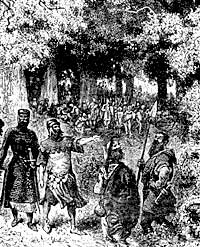

A Victorian depiction of the outlaws in Sherwood Forest.
Oral
There are two main periods in which the Robin Hood legend can be argued to have demonstrated a truly oral format.
The first is the somewhat misty early history of the tales, in which it is believed they existed primarily as a ballad told and re-told by word-of-mouth, before their later written publications. Indeed the earliest written versions of the tales, the manuscripts of Robin Hood and the Monk and Robin Hood and the Potter appear to have been intended for recitation by a minstrel, due to their ABAB rhyming pattern, who would likely have told these tales as they travelled the countryside entertaining to earn their way. However, it is important to be aware that there is no certainty of this fact; as we have no way of knowing what was said or told prior to written records it is impossible to be sure of the repertoire of the early minstrel. Even more misleadingly, some literary forms sought to copy oral styles of transmission in the telling of their tales, even if they had never themselves been sung or performed.
The second is the slightly later transformation into dramatic productions which began with the Tudor and Jacobean period. Although we are not sure when the outlaw first took to the stage in this manner, the now famous letter of Sir John Paston to his brother John on 16th April 1473 reports that he had been deserted by the servant he had employed to play Saint George, Robin Hood and the Sheriff of Nottingham. Sadly the texts from only three late medieval plays of Robin Hood still survive, all of which are clearly derived from the ballad tradition. They are: Robin Hood and the Sheriff which survives in a manuscript fragment c.1475; Robin Hood and the Friar and Robin Hood and the Potter both printed in William Copland’s 1560 edition of the Gest.
Robin Hood played a significant role in the fifteenth and sixteenth century mummer’s plays – popular dramas composed primarily of mime. His story was certainly well suited to this format and to the stage in general, because of the quick pace, the frequent disguises and numerous fights already visible in the ballads. If considered alongside the other key protagonists of the mummers’ play, such as Saint George, the outlaws appearance in this format also seems to indicate the widespread popularity of his adventures.
The sixteenth century also saw Robin Hood take a key role in the May Games. Varying from village to village the exact structure of these games was never set in stone, but would seems to have generally included procession, dancing and plays. The earliest available reference to Robin Hood appearing in this context is from 1476 onwards at Croscombe in North Somerset. In 1498 in Wells the Robin Hood play is recorded as being accompanied by dancing and church ales (sponsored brewing to raise money for the parish). More detail is provided by the records from Kingston-on-Thames between 1507 and 1529, which show regular expenditure on costumes for Robin Hood, and also associates him with an un-named friar, the Maid Marian and Little John.
This affectionate re-enactment of the outlaw legend was even embraced as far north as Scotland, where he played a key role in the springtime festivities; even more so than in many areas of England Robin Hood presided over a variety of dances, fairs, plays and games.
From his role as the lord of May Robin Hood was to become involved in the already well-established Morris dances, and it was here that he was to become forever intertwined with the stories of Maid Marian and Friar Tuck.
The next step in the outlaw’s dramatic development was to occur at the hands of the Elizabethan playwrights:
- George Peele’s Edward the First, sir named Edward Longshanks circa 1593, incorporates a Robin Hood game and has great similarity to the ballad Robin Hood and the Potter.
- Anthony Munday’s plays of Robin Hood, c.1597-8, are without doubt the most influential of this sort, introducing many of the features which are still today considered key to the legend: he was the first to identify Maid Marian with one of the Matildas persecuted by King John and to transform the previously untitled Robin Hood into Robert, Earl of Huntingdon.
- A Pleasant Comedie called Looke About You of 1600 begins with this Earl of Huntingdon entering stage.
The popularity of such dramatic performances declined by the mid-seventeenth century, being briefly rekindled as musical drama in the eighteenth century:
- Robin Hood made regular appearances in a ‘musical entertainment’ at Drury Lane.
- A comic opera called Robin Hood of Sherwood Forest by Leonard MacNally, which was performed two or three times a season at the Theatre Royal, Covent Garden during the last decade of the eighteenth century.
Yet this did not mean the end of Robin Hood’s relationship with the stage, as writers have occasionally continued to feature tales of the outlaw in their theatrical works, as with Alfred Noyes’ Robin Hood: a play in five acts.
References
- R. B. Dobson and J. Taylor, Rymes of Robin Hood (1997)
- H. Phillips (ed.), Robin Hood: Medieval and Post-medieval (2005) a collection of interesting essays.
- L. Potter (ed.), Playing Robin Hood: The Legend as Performance in Five Centuries (1998) a collection of essays discussing Robin Hood’s dramatic representations.
- Alfred Noyes, Robin Hood: a play in five acts
Available from King’s Meadow Campus East Midlands Collection Not 1.S16 NOY.